Watch Market Trends and Predictions: 2023 and Beyond
by Raman Kalra
Raman Kalra is the founder of The Watch Muse blog and has kindly agreed to share some of his articles with us here on Quill & Pad.
___________________________
Throughout 2022, there has been an economic shift globally. Thankfully, we have moved forward from the pandemic, however, we are now entering a period of higher interest rates in response to inflation. With this, consumer patterns will change and the watch industry will be affected. So I thought it might be interesting to look at historical watch trends and give my predictions on what shifts we will see on our wrists over the next 5-10 years.
Obviously, the future is impossible to know, so this comes down to opinion and I would love to hear if you agree or not. It will be intriguing to visit this post and update it in the following years. Please note that there is no financial advice in this post.
Watch Trends
Before we think about how trends will evolve going forward, we need to consider where we are now. The growth of interest in watches has been exponential over the last 10 years. A lot of this has come down to the impact of social media. It has created greater awareness of watches and they are now reaching a wider audience than ever. This can come from the social status aspect to the accessibility of more niche pieces that even watch enthusiasts had not been aware of previously.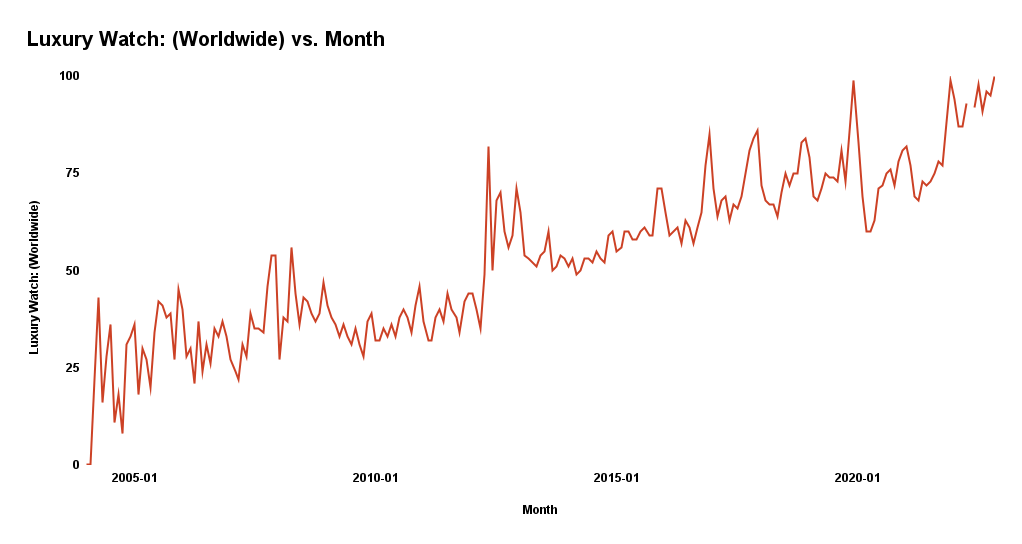
On top of the social media angle, something we have witnessed in the last few years is the solidification of watches viewed as investments. There was always the store of wealth thinking associated with luxury watches, but with the stock markets performing well and investors looking for other opportunities for yield, asset classes like cryptocurrencies took off.
Watches happened to be another one of these asset classes and it is a significant reason why we can no longer go into a store and buy a popular model without joining a waiting list. These phenomena are widely known, but ignoring the price aspect, what changes have we seen in watches?
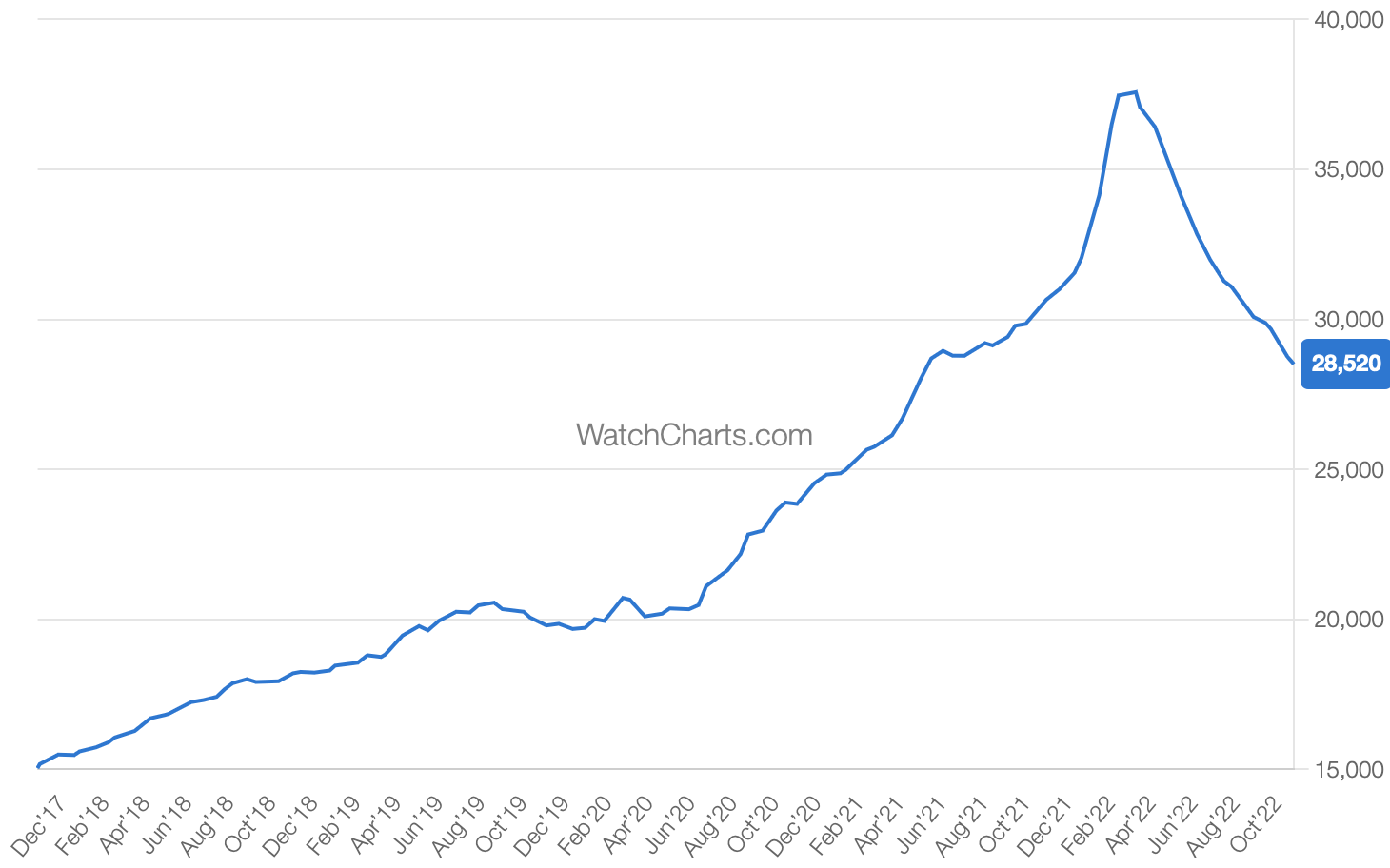
To gain a broader view of how the landscape has evolved, we need to look at what watches were being produced in specific timeframes. This is not an easy task considering the vast number out there, but also finding a database where this information could be easily accessible. To get around this, I have focused on using Chrono24. For those who have not used Chrono24 before, it is an online watch marketplace where both dealers and private users buy/sell watches. The benefits of using Chrono24 are the wide range of products they have on offer from around the world and their great filtering system allowing us to analyze what is on sale.
The aspects we will consider here are case materials, dial colors, and case diameter. All data is correct as of 10th November 2022, but even if there are fluctuations, given the size of the numbers and the fact only the proportions are considered, it should reflect the overriding trends. The trends should not be hugely sensitive to minor changes as more/fewer watches make their way to the marketplace.
I should also caveat all the data below is reliant on correct and accurate reporting of those who have listed the watches. There will inevitably be mistakes such as listing a Rolex Datejust as 37mm instead of 36mm by accident, or selecting “Gold” instead of “Two-tone”, but hopefully these mistakes are minimal and should not affect the outcomes significantly.
Case Materials
Case materials are a good place to start. We all hear about stainless steel sports watches, but when it comes to what is actually on offer, how do the broader trends look? Do the trends resemble economic conditions or fashions of the time? One extra point that needs to be appreciated when we look at case materials is the progress made in material science, allowing for new case materials to be used e.g. bronze, ceramic and titanium. For this exercise, stainless steel, gold (yellow, white and rose), two-tone and other (bronze, ceramic and titanium) are the categories. 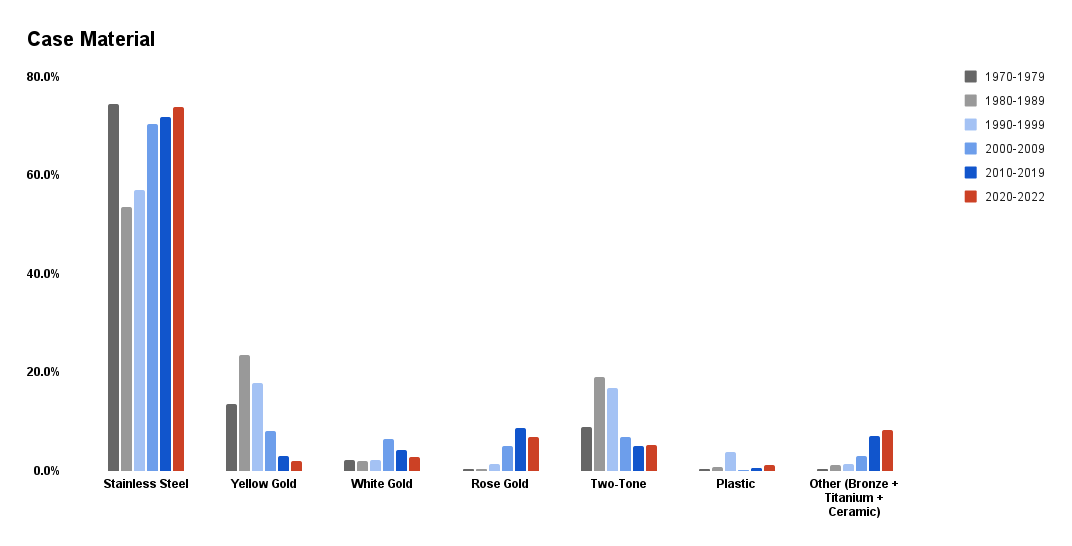
Looking at the chart above, stainless steel is the top material used no matter what time period we look at. Stainless steel is widely used given it looks attractive, is non-corrosive, has high durability and is relatively low-cost. Interestingly, in the 1970s stainless steel is the highest as a proportion of total watches considered, even when compared to the present. This could be down to the fact that the 1970s were not great economically and the watch world was dealing with the quartz crisis.
In this context, stainless steel sports watches were born and steel is cheaper than gold, meaning watch brands would tend to use this as they fought off the cheaper, quartz competition. We are now also experiencing 1970s fashion in terms of watches, and stainless steel watches from that time are in demand so it could be that those who have them are looking to cash in!
As we move forward into the 1980s, there is an uptick in the use of yellow gold and two-tone watches at the expense of stainless steel. This then starts to drop off as stainless steel once again sees its popularity increase in the 2000s, but here we do start to see more use of white and rose gold. We can also see the increase in the Other category, which has grown exponentially as it has become cheaper to use these new materials. Similarly, as consumers are looking for more unique watches, it has allowed brands to experiment with materials.
Dial Colors
Dial colors are very much a fashion. Without looking at any data, we are aware that blue has been a big hit recently. It is easy to think of examples such as the Patek Philippe Nautilus, Audemars Piguet Royal Oak or IWC Pilot’s watches in navy. However, is this rise meaningful or is it because brands are marketing blue more heavily?
What about other colors and how has this affected the product of black and white watches? The dial colors have been broken down into black, white/silver, gold/champagne, blue, grey, green, red and other (including yellow, orange, brown and pink).
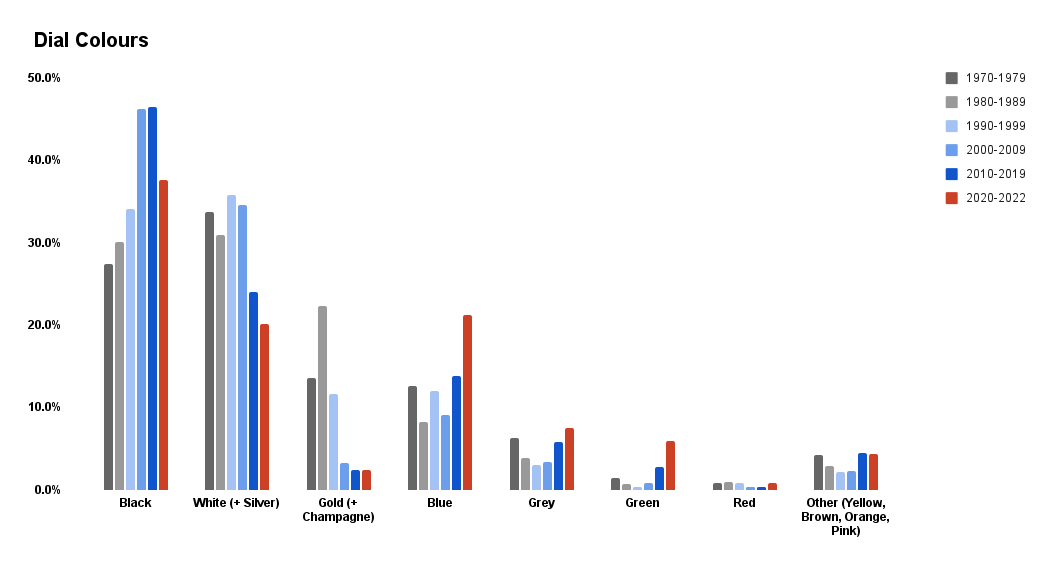 When looking at the data across decades, interestingly there has been a notable drop in the proportion of watches that have either white/silver or gold/champagne faces. Understandably, the use of gold/champagne dials is dictated by fashion trends and it is no surprise that the greatest use of these colors was in the 1980s when they fit perfectly with two-tone cases. What is more surprising is the large decline in white/silver dials. This is less clear; however, these colors have typically been used more frequently on dress watches.
When looking at the data across decades, interestingly there has been a notable drop in the proportion of watches that have either white/silver or gold/champagne faces. Understandably, the use of gold/champagne dials is dictated by fashion trends and it is no surprise that the greatest use of these colors was in the 1980s when they fit perfectly with two-tone cases. What is more surprising is the large decline in white/silver dials. This is less clear; however, these colors have typically been used more frequently on dress watches.
If we think about broader consumer trends, sports watches have been the most in-demand as they are versatile and are a great entry point to luxury watches as they can be considered one-watch collections in many cases. In this context, the decline of dress watches makes sense.
Interestingly, between 2000-2009, it looks to be a transition period whereby black dials were extremely popular as sports watch interest picked up, the decline of white dials had not started and there were not many other dial color options as brands did not have the confidence to produce them. This led to black and white dials accounting for ~80% of watches in this time period. In the last 10 years, there has been a big uptick in blue dials, but also grey has seen a marginal gain, whereas, green has been the recent gainer from 2020-2022.
All of this has come at the expense of white dials. As watches are being worn more widely, there is more social media influence and more informal workplaces, so it would not be surprising to see the range of colors used to broaden and become more common. Look at how popular the colorful Rolex Oyster Perpetuals were!
We are now seeing the likes of Omega introduce colors in the Aqua Terra and Grand Seiko using the full-color spectrum across different models, but also smaller brands such as Zodiac gaining popularity given the more daring color combinations.
Case Size
What case size works for you will ultimately depend on the size of your wrists. However, tastes influence the sizes that are in demand and how we view watches – are they tools or primarily jewellery? The categories have been broken down into a small range of case diameters. This should capture the broader trends and account for any minor errors in classification on Chrono24 e.g. a 40mm watch that has been classified as 39mm. 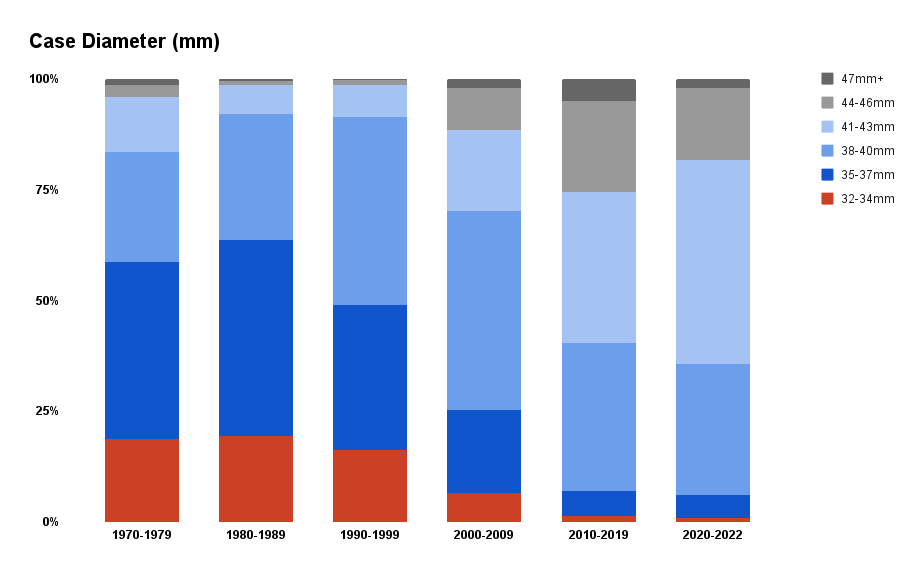 When we look at the trends across decades, smaller watches were more popular in the past. Once again, this should not be a surprise as watches were still considered to be timekeeping tools and the larger models were reserved for specific functions such as diving or for pilots. Looking at the chart, you can see that the proportion of watches in the 35-37mm category has dropped since 2000 and is now a relatively small category.
When we look at the trends across decades, smaller watches were more popular in the past. Once again, this should not be a surprise as watches were still considered to be timekeeping tools and the larger models were reserved for specific functions such as diving or for pilots. Looking at the chart, you can see that the proportion of watches in the 35-37mm category has dropped since 2000 and is now a relatively small category.
On the other hand, the proportion of watches sized 41mm and larger has grown, and now the 41-43mm category is the largest. Finally, the 44-46mm range grew in the 2000s and peaked between 2010-2019 as consumers looked to larger watches. Think of the growth in popularity and how that fed through into how brands reacted. Audemars Piguet launched the Royal Oak Offshore collection just to address this demand and Rolex created the “Super Case” increasing the stance of the Professional range on the wrist. This has started to decline since 2020 and is being downsized into the 41-43mm category.
When looking at the case diameter data, it did look slightly different to what I expected. It feels as though you read more about smaller watches and how the ideal sizes are between 36-39mm, but what we see here is the range including 36mm is relatively small. On top of that, the 38-40mm range has not grown in size when compared to the 2010-2019 time period, so despite the increase in press coverage of smaller watches, the reality is, nothing has changed here. The larger shift is the downsize of oversized watches.
Predictions
Now that we have considered the current watch trends, what can we expect from the future? These are my predictions and they might not line up with the trends we have seen above!
Dress Watch Comeback
Let’s be honest, sports watches have been the hype for some time. It is understandable why – they are extremely versatile and many can be viewed as a one-watch collection. However, this demand has created some high prices, and despite the market softening during 2022, they are still high. As we enter more difficult economic times, there are two trains of thought as to why we might see dress watches make a comeback.
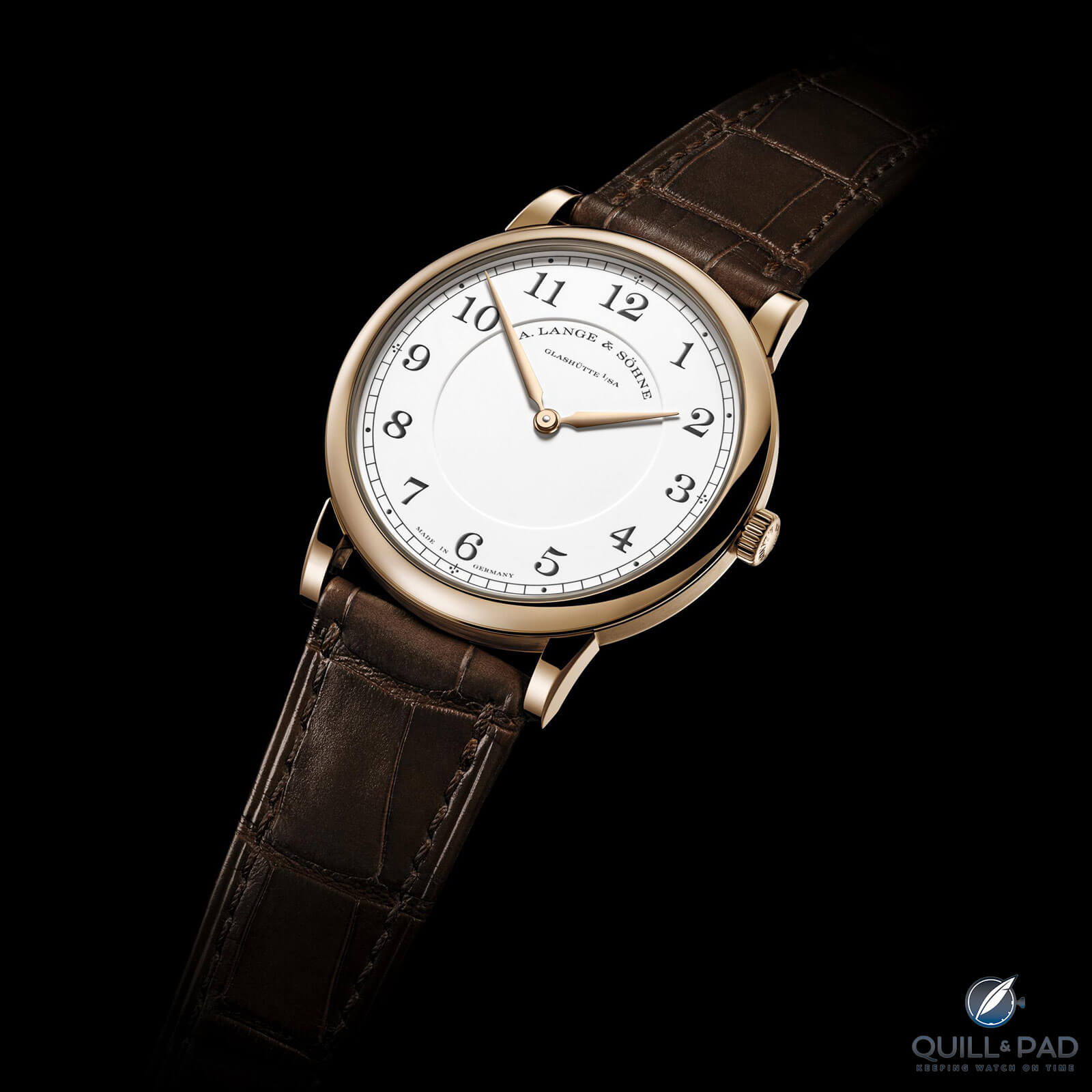
A. Lange & Söhne 1815 Thin Honeygold Homage to F.A. Lange
Firstly, consumers need to be savvier with their money. More thought will need to go into luxury purchases (for most), and with that, spending over RRP on a watch to beat a waiting list starts to sound even more questionable. This should help soften grey market prices, but it should also lead consumers to search for better value for money. This is where dress watches enter. Most of the top brands have dress watches in their collection, but they have not received the same attention and therefore, are trading below retail price. That does not mean they have not been engineered as well, have substandard movements or aesthetics. I believe this will be realized and you will see demand start to pick up.
The second train of thought is with harder economic times, ‘stealth wealth’ becomes more desirable. What do I mean by this? Showing your wealth becomes less favorable, whether it be around your colleagues or friends, but also in public. There has been an increase in watch theft in metropolitan areas, which has been widely reported. This factor again pushes the idea that subtly will be in demand and dress watches tend to fall into this bracket.
Colorful Dials (including White)
As touched upon when discussing dial color trends, I believe we will see a wider range of colors used in watches across price ranges. Again, the bright Rolex Oyster Perpetuals were a massive hit and we have seen other brands follow suit. There are a number of examples: Omega Aqua Terra, Tag Heuer Monaco’s in green and burgundy, IWC Pilot’s watches in green and brown, Sinn Watch 556 in multiple pastel colors … the list goes on.
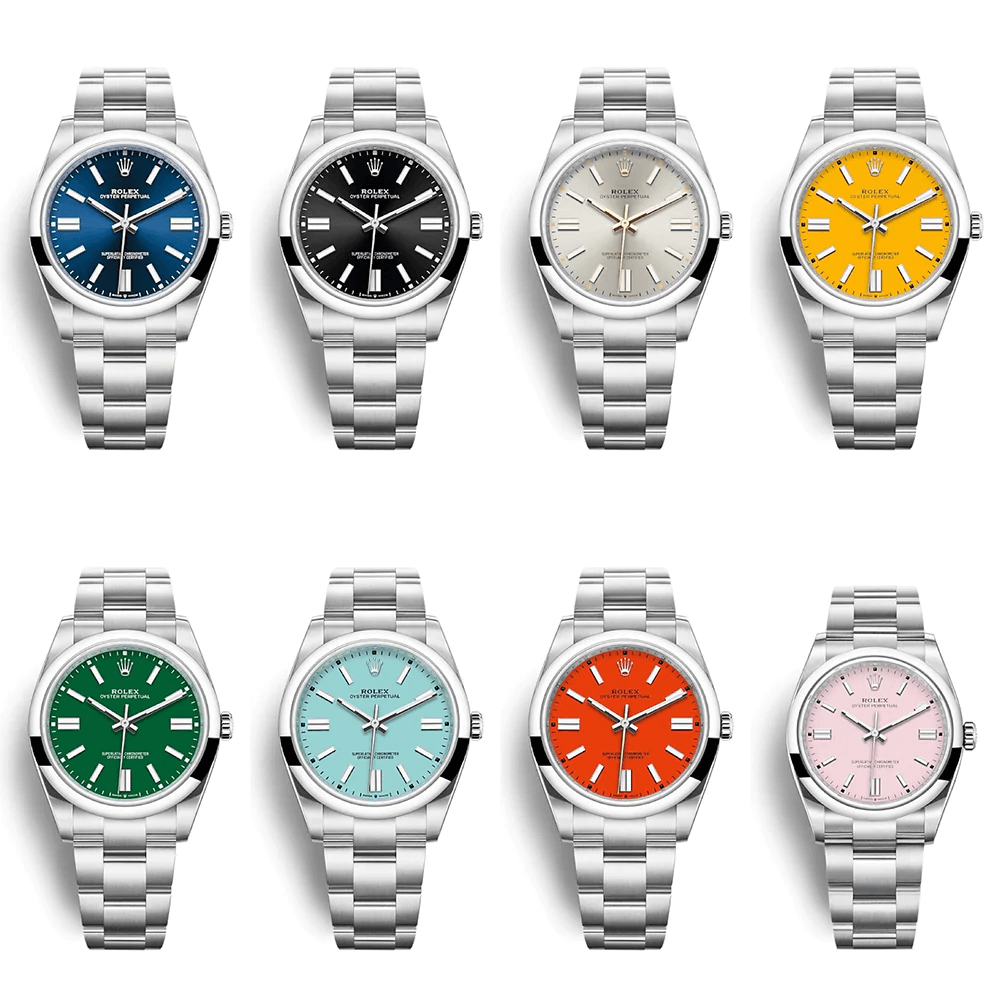
Rolex Oyster Perpetuals with colorful dials (photo courtesy Everest Bands)
We are seeing social media play a large part in this as the colorful dials are aesthetically pleasing and create some great photos! But also, the workplace has become more casual and it is now more acceptable to wear brighter colors in formal situations. In some, if not most industries, smart-casual has become the standard and with this, freedom of expression has improved.
No longer are dark suits the dress code and watch brands are realizing this. Let’s not forget that freedom of expression has improved in all areas of life, not just the workplace! It won’t be all color, however. I do also believe there will be an increase in white dials. There has been that notable shift that we saw in the chart above, but if dress watches do pick up in demand, white dials should benefit on the back of this! I hope this is true as I do like white dials that are done well and would love to add one to my collection in the future.
Two-Tone Resurgence
Over the last 5-10 years we have seen the 1970s dictating watch trends. Stainless steel sports watches with integrated bracelets have become all the rage. They are beautiful watches and there are now many examples for sale across all price points. I don’t know whether it is my own fatigue with them, but it seems as though we have passed the peak. There does not seem to be the same excitement when a new variation is released. When a new model is released, there is not the same wow factor, but rather the impression of having seen the design before.
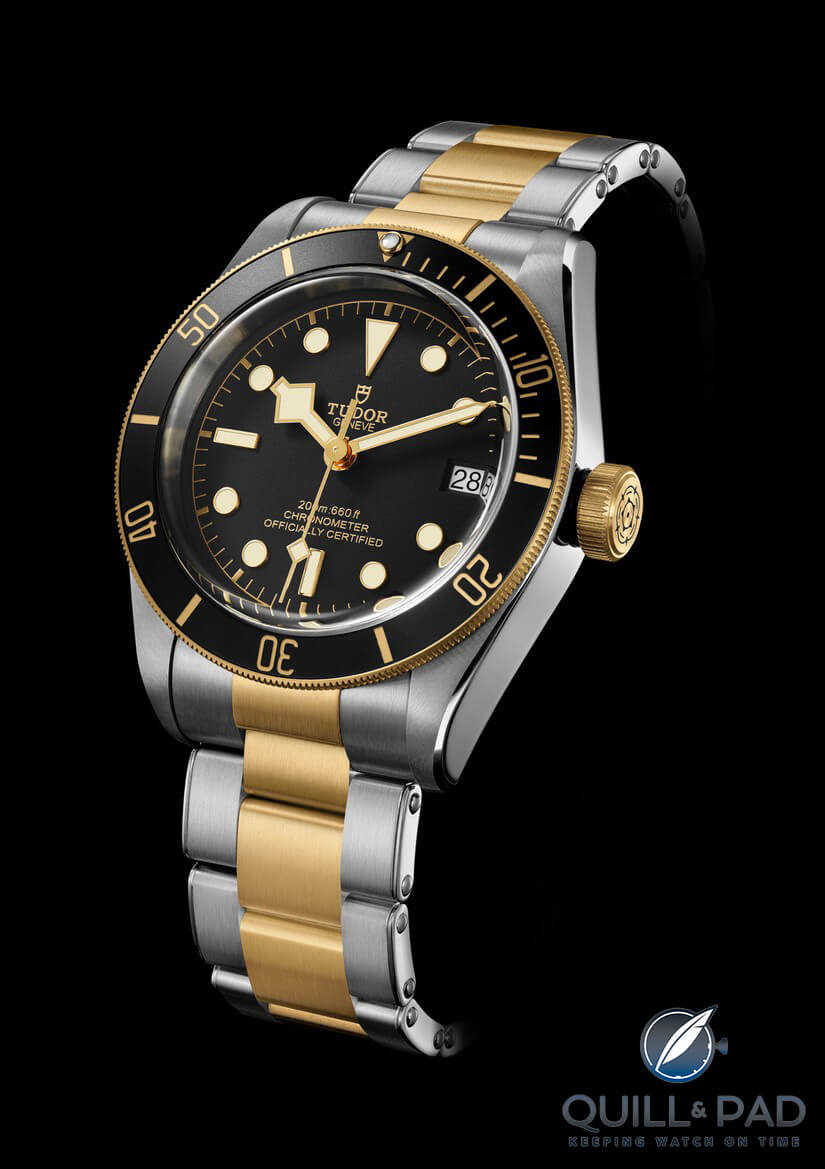
Two tone Tudor Black Bay
Look at the recent Bremont Supernova as an example. If we are moving on from the 1970s trends, then potentially the 1980s is the next historical time period in which design cues are taken. If this were to be true, we should see more brands looking to use two-tone (and yellow gold for that matter).
Two-tone has already seen some resurgence. Rolex released the Explorer I in two-tone, the GMT-Master II “Root Beer” is a very popular watch and I believe we will see gold and stainless steel being used in various combinations across more brands.
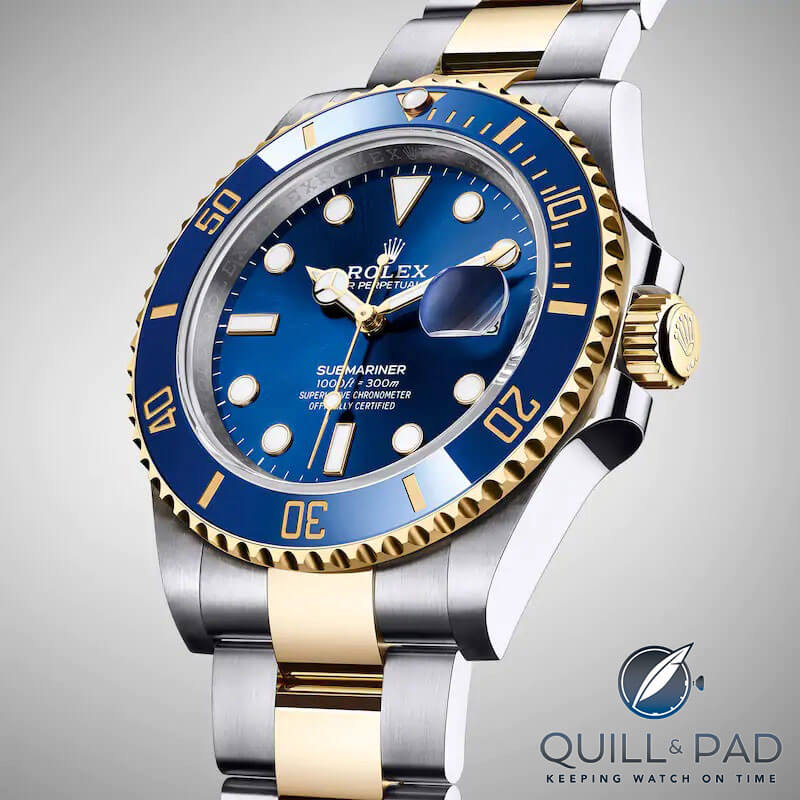
Rolex Oyster Perpetual Submariner Date two-tone
This holds true if we expect the number of consumers buying fully gold watches to drop, they could end up wanting to purchase a two-tone as there is that element of gold still there. Likewise, those looking for more value are now realizing that many two-tone models are the same price, if not cheaper, than their stainless steel counterparts that are seeing elevated prices.
Case Sizes Fall
Smaller diameter cases are something that we are already currently experiencing, and even though the data does not show much of a shift under the 40mm case size, I expect this category of <40mm to continue to grow. We are seeing more coverage of smaller watches, popular models are now being reduced in size to account for those with smaller wrists, and there is more social acceptance around wearing smaller watches for men. On top of this, vintage watches have gained in popularity and with that, the benefits of a smaller watch are being felt by more consumers, and if we do see dress watches make a comeback, these also tend to be on the smaller side. Further to this, if we see trends turn towards the 1980s as the next fashion influence, there could be another push towards slightly smaller timepieces. My feeling is we see the 35-37mm and 38-40mm brackets increase at the expense of the 41-43mm and 44-46mm ranges.
Conclusion
I believe we are now at an inflection point. We have seen a sharp increase in demand for watches for a number of reasons, but given the economic downturn and changes in fashion, there will be a shift in what we see on our wrists in the coming years. Looking at the historical trends we can see that case sizes have progressively got larger since the 1970s, the use of materials has become broader despite stainless steel still being the most widely used and the color palettes of dials have widened.
There are some trends that are surprising: the drop in white dials on offer since 2010 and the greatest proportion of watches falling in the 41-43mm category despite coverage of smaller pieces picking up in the media. Looking ahead, predictions are difficult to make about anything. However, I believe we will start to see the resurgence of dress watches as consumers look for better value and items that are less ostentatious. Despite this, the use of brighter dial colors is here to stay.
Brands are comfortable that they can experiment in this department and they will continue to do so as consumers look for variations that suit their style in a more expressive world. It won’t stop there. I see two-tone watches making a comeback – those looking for all gold might be deterred by the broader stock market and look towards two-tone, and those looking at stainless steel will start to appreciate the extra value to be had by a similar-priced two-tone variant.
Please let me know your thoughts in the comments below.
You can read more articles by Raman Kalra at www.thewatchmuse.com.
You might also enjoy:
Watch Design: Originality, Similarity, Or Imitation?
Rolex Case Study: How Many Watches and How Much Money Does Rolex Make?
Trends: Not All Watches Are Created Equal
The Death Of The Dress Watch: Is It Time To Write Its Obituary?
Leave a Reply
Want to join the discussion?Feel free to contribute!



Great article. It was interesting to see that the 41-43mm case size current popularity especially with all the media’s preference to sub 40mm. Perhaps it takes a number of years for the brands to react and develop there range. I would love the next generation Vacheron Overseas to be 38/40mm. The dress watch certainly deserves a bigger stage there some great buys preowned in precious metals. My only doubt though is two tone. These can be very bling not exactly stealth wealth. I would love to see many more brands offer easy change strap options and bring on more colourful dials and straps. Love the Oris ProPilot X Kermit.
Hi Christopher – thanks for the comment and happy you enjoyed the article!
I think the case size findings were what surprised me most as well. It highlights the disconnect between watch enthusiasts that appreciate the smaller size vs. everyone else. I think Rolex launching the Explorer I in 40mm yesterday highlights this.
On the two-tone side, you could be right that it is flashy. Another angle though is that the 1980s is when we saw the two-tone fashion take off. If we just experienced a 1970s wave of inspiration hitting the market, maybe the 1980s is next?
Hello Raman, superb article , stunning piece of work. I go d’accord with 90% of your article. Regarding the increase of the 35,37, 38mm case diameters I am not so sure if we will see a significant ( let’s say 15-25 percent) increase over the next five years. Despite the fact this upcoming 1980’s trend, and the dress-watch trend( btw, casual dress is and will be more and more the new normal, and many dress watches are made of precious metals like yellow and white gold , which would contradict the upcoming desire of the new modesty, where also the 1980’s were not famous for) might see a revival. I presume too there will be an increase of smaller wrist sizes, but not significantly. Firstly because men and women are getting taller and taller and therefore getting bigger wrists as well, and even if social media is telling us, small case sizes are looking cool, are trending because showing you are masculine enough to wear these sizes, it still looks on many wrists like if these guys are avoiding to grow up. Secondly watch companies need at least 4-5 years to creat new in-house , here downsized ( for 35-38 case diameter) movements. On the other side, Tudor with its new superb Tudor Black Bay 54 ( referring to the 1954 Model 7922) shows impressively that if there is a wish, there will be a way to create this adaption of the movement for a smaller case diameter , pretty quickly. So I guess there will be some downsize diameter changes in the future, but if they will reach a significant figure , I have my doubts. Best wishes from Berlin.
Hi Marc – thanks for the comment and happy you enjoyed the article.
You make a very good point on the development of smaller cases and movements, especially from the likes of bigger watch brands that move slower. I do think we are seeing this shift, but you might be right that it still makes up a smaller proportion of what’s on offer. It feels as though these watches are the ones geared more towards the enthusiasts. Even the Black Bay 54 being a great example shows that this type of trend is occurring. On the other side, with Rolex doing a 40mm Explorer as I mentioned above, it does highlight there is still demand for larger pieces from the wider community.
I agree dress watches tend to be more precious metal, but I still personally believe a yellow gold dress watch (I am imagining a Calatrava here) has a level of modesty not found on the sports watch side. That was really my angle more than anything.
Thanks again and best wishes from London!
Hello Raman, the funny thing about this ‘ wrist-sizes- getting- smaller‘ discussion especially among enthusiast’s already infected me… when I think couple of years ago in the early 2000 I started with a 44 panerai luminor, get rid of in 2016, then because I did not like to go down too quickly to smaller wrist sizes, i decide in 2017 to switch to a rolex sea dweller 43 mm, and i have a 7” wrist size, but still felt especially in summer too heavy and chunky… so I get rid of this one two and bought from the nice sales price before the prices cooled downed this year , a rolex sub no date and a rolex date just both in 41 mm and 2023 birth date… oh and two years ago the superb cartier santos medium… just saying I am guessing I am already in the middle of a down-sized wrist storm…cheers from berlin
I believe 41mm is an inflection point for mfg, as the top end of a large offering. I think grouping this size within a group from 41-43mm discounts what may really be going on with size. I’d like to see this size broken out by itself or grouped as 40-41mm.